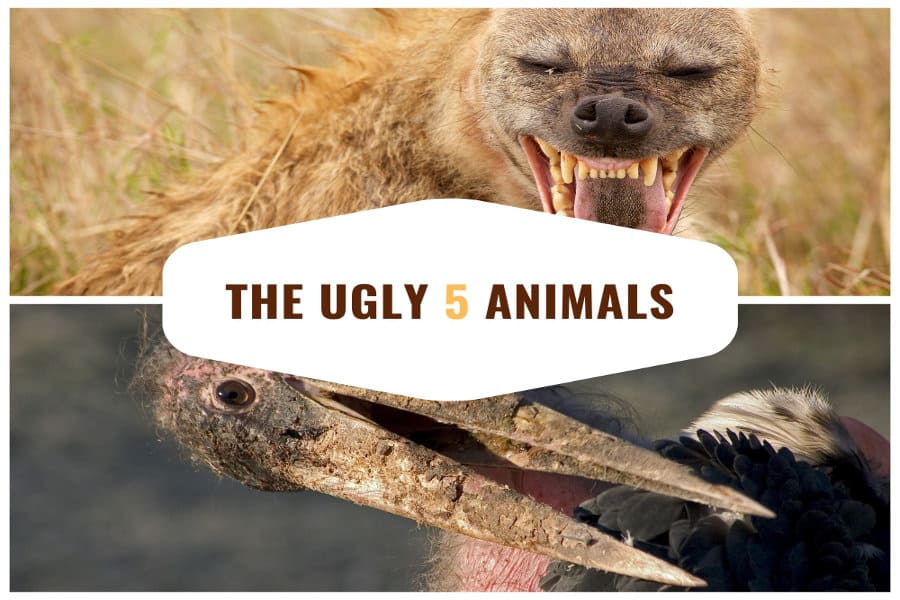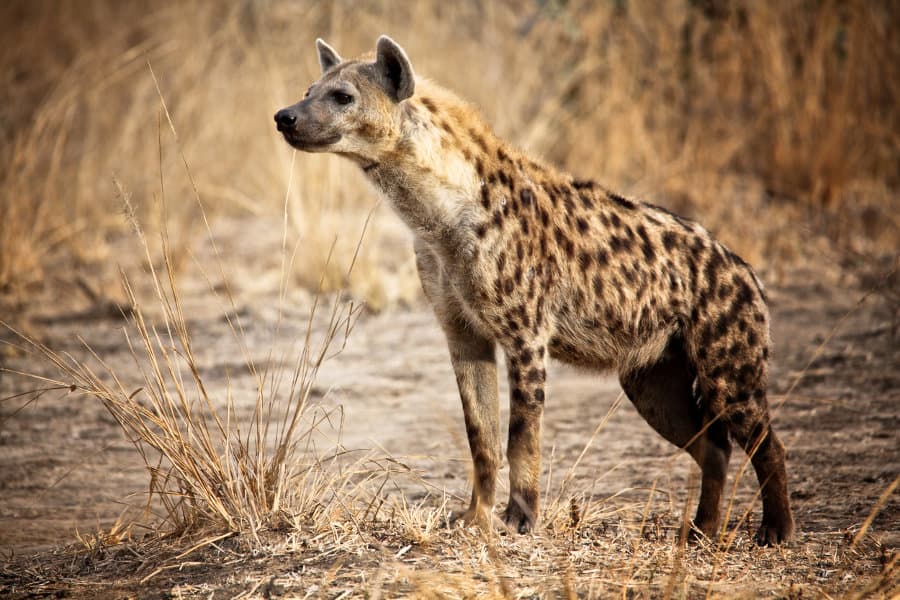When it comes to animal spotting, most people are well aware of the ‘Big 5’. Some may even have heard of the ‘Little 5’.
However, there’s a group of animals in Africa that have slipped through cracks of the public eye. Do you know anything about the ‘Ugly 5’? Chances are, you don’t. Most people haven’t heard of them.
The term ‘Ugly 5’ refers to a group of the five ‘ugliest’ animals in Africa that you can spot on a safari. It’s a rather brutal classification, and in reality, all animals are beautiful in their own way.
Yet for better or worse, these five have earned themselves an unfortunate place in the official Ugly Five listing.
Welcome to Africa’s Ugly 5 safari.
1. Marabou Stork

It’s no secret that the marabou stork is less than beautiful. They have loose pink skin, scabby looking faces, and floppy neck sacs. Not to mention their sparsely feathered heads and gangly legs.
However, these features are all critical. Their scabby, bald heads help prevent infections, while they use their bulbous neck sacs for asserting dominance and regulating temperature.
Although the marabou stork may not win any African beauty contests, it is one of the most elegant birds in flight. And it serves an important purpose in maintaining a balanced ecosystem.
Marabou storks do a lot of scavenging for food. Along with other scavengers, they’re known as the garbage collectors of the African wilderness. Not an attractive profession, but an important one.
They feast on carrion that could otherwise spread pathogens and they break through the tough hides of carcasses, making them more accessible to weaker scavengers.
2. Vulture

Some sources single out the lappet-faced vulture as the vulture’s representative in the Ugly 5. Although most of Africa’s 11 vulture species could make the cut – none are blessed with particularly good looks.
Just like the marabou stork, vultures tend to have bald, scabby looking heads. Often with unfortunate skin folds, and sometimes with unsightly, exposed ears.
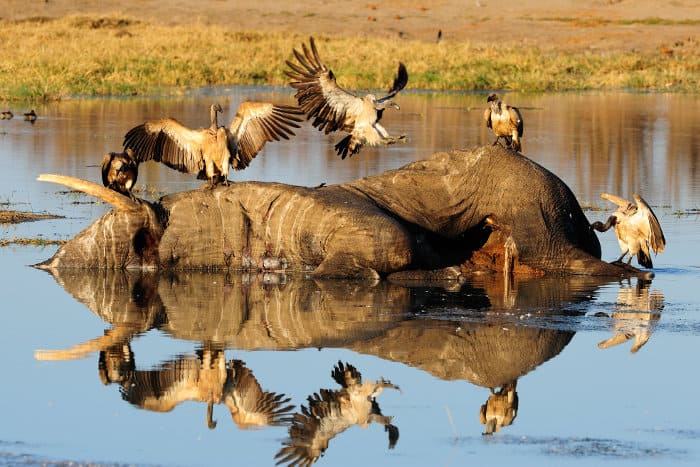
However, much like the marabou storks, vultures have a crucial role to play in nature. They’re respected members of Africa’s ‘clean-up crew’ for their ability to keep our wildlife reserves tidy.
They’re perhaps the most infamous scavengers of all, and they’re very good at what they do. In fact, they clear up to 70% of the carrion in Africa, helping prevent the spread of disease in animals and humans.
3. Wildebeest

Wildebeests may not be easy on the eyes, but they’re not terribly unattractive when compared to the other animals on this list. Besides, an ugly wildebeest wouldn’t know how ‘ugly’ it was, as their eyesight is extremely poor.
Nevertheless, they’re official members of the Ugly 5 African animals. They have wispy beards, gnarly horns, and long faces. And indeed, it’s this disagreeable appearance that earned the wildebeest its name, which is an Afrikaans word meaning ‘wild beast’.
For an unfortunate-looking animal, wildebeests certainly put on a spectacular show. The great wildebeest migration is the greatest movement of terrestrial mammals on Earth. Over a million wildebeest gallop through the Serengeti in search of greener pastures. Catching a glimpse of this action is a coveted safari dream.
4. Hyena
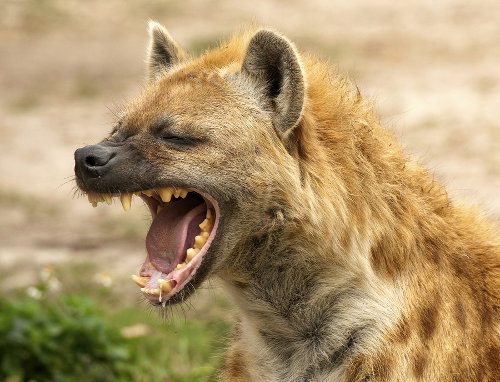
Tell a hyena that it’s ugly and it will probably ‘laugh’ in your face. In all honesty, they’re not terribly unattractive.
Sure, they have a rather odd posture, an unflattering grin, and a slightly sinister face. Their portrayal in The Lion King didn’t do much for their reputation either. But hyenas are hardly hideous, and their cubs are even particularly cute.
Hyenas are scavengers (which is starting to seem like a strong predictor of ugliness), making them important players in their ecosystems.
However, they don’t only scavenge for their food. They’re skilled hunters, too. In fact, they’re part of the most successful predators in Africa.
Their powerful jaws can crush the bones of some of Africa’s largest animals, and their strong stomach acid makes easy work of any meal. Hyenas will eat almost anything, including hoofs and bones.
There are three species of hyena in the Hyaenidae family. Namely, the striped hyena, brown hyena, and spotted hyena. The lesser-known aardwolf is an additional member in the same family.
The spotted hyena, the largest of the bunch, is also known as the laughing hyena. This is because they’re the only ones that make the stereotypical chuckling sound.
5. Warthog
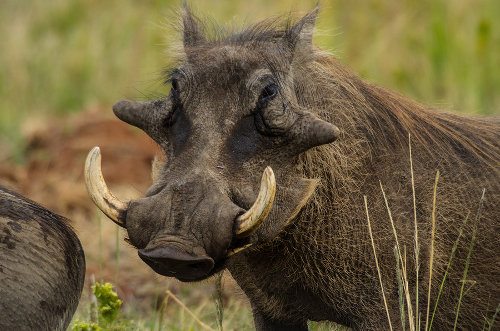
The name ‘warthog’ doesn’t scream ‘good looking’. And there’s no hiding the fact that they’re rather ill-favored in the beauty department.
Their faces are pointy with strange-looking snouts, and their tusks aren’t exactly pretty. Then there’s their leathery skin which is peppered with exactly the wrong amount of coarse hair.
Fortunately for them, they got a friendlier portrayal in The Lion King. Most people think of them as the loveable, slightly daft ‘Pumbaa’. Which, in Swahili, actually means ‘to be absentminded, careless, foolish, ignorant, lazy, stupid, and negligent’.
Traditionally, it’s a term that many Kenyans and Tanzanians use to refer to warthogs, thanks to the animal’s troublesome antics in African villages.
In reality, warthogs are quite intelligent. They sleep underground at night, yet they don’t dig their own burrows. Rather, they steal them from other animals, such as aardvarks. Not a kind move, but a clever one.
Curiously, warthogs are omnivorous, meaning they can eat both vegetation and meat. Their diet consists mostly of grass, bulbs, and roots, but they will occasionally scavenge for meat scraps. Who would have thought?
An Unsightly Summary of The Ugly 5
The Ugly Five are an odd-looking bunch with a bad reputation. Yet each of them has their own unique and fascinating story. Some are vital to their ecosystems, while others dazzle us with spectacular wild shows.
In any case, each one of them is just as interesting and worth seeing as their prettier African cousins. So keep an eye out next time you’re on safari. You might just be able to spot something a little more unique than the standard Big Five!
If you’re interested in seeing these ‘ugly’ African animals for yourself, consider booking a tailor-made, African safari.
